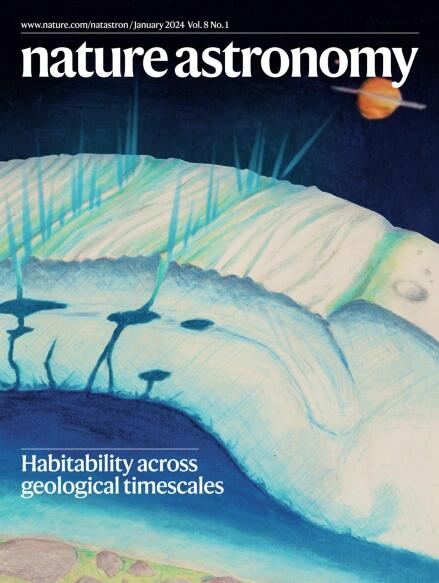A solar C/O ratio in planet-forming gas at 1 au in a highly irradiated disk
IF 14.3
1区 物理与天体物理
Q1 ASTRONOMY & ASTROPHYSICS
引用次数: 0
Abstract
The chemical composition of exoplanets is thought to be influenced by the composition of the disks in which they form. JWST observations have unveiled a variety of chemical species in numerous nearby disks, which show substantial variations in the C/O abundance ratio. However, little is known about the composition and C/O ratio of disks around young stars in clusters exposed to strong ultraviolet radiation from nearby massive stars, which are representative of the environments where most planetary systems form, including ours. Here we present JWST spectroscopy of d203-504, a young 0.7 M⊙ star in the Orion nebula with a 30 au disk irradiated by nearby massive stars. These observations reveal spectroscopic signatures of CO, H2O, CH3+ and polycyclic aromatic hydrocarbons. Water and CO are detected in absorption in the inner disk (r ≲ 1 au), where the estimated gas-phase C/O ratio is 0.48, consistent with the solar value and that of the Orion nebula. By contrast, CH3+ and polycyclic aromatic hydrocarbons are found in the extended surface layers of the disk. These results suggest that gas in the inner disk is chemically shielded from ultraviolet radiation, whereas the surface layers of the disk experience ultraviolet-induced chemistry, potentially depleting their carbon content. JWST reveals the chemistry of the disk of a young star in the Orion nebula, showing that it has water and CO in its inner regions that are shielded from UV radiation, whereas UV-processed molecules such as CH3+ and PAHs are detected in surface layers.


在一个高度辐射的圆盘上,在1au处形成行星的气体中的太阳C/O比率
系外行星的化学成分被认为是由它们形成的圆盘的成分所影响的。JWST的观测揭示了许多附近圆盘中的各种化学物质,这些物质显示了C/O丰度比的实质性变化。然而,对于暴露在附近大质量恒星的强紫外线辐射下的星团中年轻恒星周围的盘的组成和C/O比率知之甚少,这是大多数行星系统形成的环境的代表,包括我们的。在这里,我们展示了猎户座星云中一颗年轻的0.7 M⊙恒星d203-504的JWST光谱,它有一个30 au的圆盘,被附近的大质量恒星照射。这些观测结果揭示了CO、H2O、CH3+和多环芳烃的光谱特征。在内盘(r > 1 au)的吸收中检测到水和CO,其中估计的气相C/O比为0.48,与太阳和猎户座星云的值一致。相比之下,CH3+和多环芳烃存在于圆盘的延伸表面层中。这些结果表明,内盘的气体在化学上屏蔽了紫外线辐射,而盘的表层则经历了紫外线诱导的化学反应,潜在地耗尽了它们的碳含量。
本文章由计算机程序翻译,如有差异,请以英文原文为准。
求助全文
约1分钟内获得全文
求助全文
来源期刊

Nature Astronomy
Physics and Astronomy-Astronomy and Astrophysics
CiteScore
19.50
自引率
2.80%
发文量
252
期刊介绍:
Nature Astronomy, the oldest science, has played a significant role in the history of Nature. Throughout the years, pioneering discoveries such as the first quasar, exoplanet, and understanding of spiral nebulae have been reported in the journal. With the introduction of Nature Astronomy, the field now receives expanded coverage, welcoming research in astronomy, astrophysics, and planetary science. The primary objective is to encourage closer collaboration among researchers in these related areas.
Similar to other journals under the Nature brand, Nature Astronomy boasts a devoted team of professional editors, ensuring fairness and rigorous peer-review processes. The journal maintains high standards in copy-editing and production, ensuring timely publication and editorial independence.
In addition to original research, Nature Astronomy publishes a wide range of content, including Comments, Reviews, News and Views, Features, and Correspondence. This diverse collection covers various disciplines within astronomy and includes contributions from a diverse range of voices.
 求助内容:
求助内容: 应助结果提醒方式:
应助结果提醒方式:


